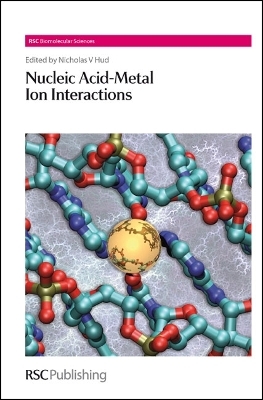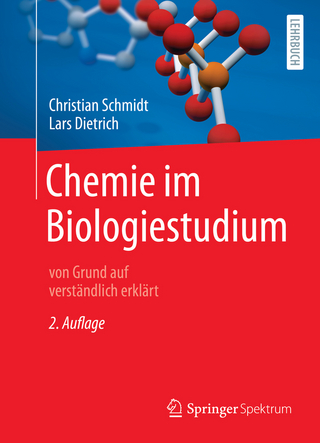
Nucleic Acid-Metal Ion Interactions
Seiten
2008
Royal Society of Chemistry (Verlag)
978-0-85404-195-4 (ISBN)
Royal Society of Chemistry (Verlag)
978-0-85404-195-4 (ISBN)
- Lieferbar (Termin unbekannt)
- Versandkostenfrei innerhalb Deutschlands
- Auch auf Rechnung
- Verfügbarkeit in der Filiale vor Ort prüfen
- Artikel merken
Provides a perspective on nucleic acid-metal ion interactions with an emphasis on experimental biophysical studies which will prove indispensable to biophysicists and molecular biologists.
Natural biochemical processes are routinely being discovered in living cells that involve RNA. Some of these processes, such as RNA interference, are now being exploited for biotechnology and medicinal applications. DNA has also proven in recent years to be more than a passive storehouse of information. For example, non-B-form DNA structures formed by G-rich DNA have been shown to participate in the regulation of gene expression, a discovery that presents new possibilities for drug targets in the genome. The current quest to understand how nucleic acid functions at the most fundamental level requires that we have a detailed understanding of nucleic acid-metal ion interactions. Because RNA and DNA are polyanions the structure and biological function of these biopolymers depends strongly on their association with metal ions. While this intimate connection between metal ions and nucleic function has been appreciated for decades, the noncovalent and dynamic nature of these interactions has continually presented challenges to the development of accurate and quantitative descriptions. Over the past few years the development of solution state spectroscopic techniques and the achievement of high resolution X-ray crystal structures have provided tremendous insights into the nature of nucleic acid-metal ion interactions, including direct evidence for their importance in determining nucleic acid structure, from the dictation of folding pathways followed by large RNA molecules to the subtle modulation of DNA groove widths. This new book provides a comprehensive review of the experimental studies that define our current understanding of nucleic acid-metal ion interactions with a particular emphasis being placed on experimental biophysical studies. However, the book is not merely a current review of the literature, as original material and fresh perspectives on published results are also presented. Particularly noteworthy topics include: -The chapter by Williams and fellow workers which reviews information provided by x-ray crystal structures and discusses what this information has revealed about the unique nature of Mg2+ interactions with RNA phosphate groups. The authors provide fresh insights, based upon structural comparisons, for how these interactions govern the local folding pathways of RNA. By dedicating separate chapters to the participation of metal ions in the kinetics and thermodynamics of RNA folding, this volume provides a more in depth treatise of both areas than is typically possible for reviews in which these two related, but distinct, topics are combined -Polyelectrolyte models of nucleic acids have proven to be extremely valuable for understanding the sequestering counterions in a so-called diffuse cloud around polymeric DNA. J. Michael Schurr provides a comprehensive review of polyanion models. Despite the success of polyelectrolyte models in describing some physical properties of nucleic acids, this topic is not always sufficiently understood by many researchers to make use of these models and this chapter serves as a valuable and up to date introduction to this topic. -The chapter by Pizarro and Sadler on metal ion-nucleic acid interactions in disease and medicine is complemented by a chapter by Lippert on coordinative bond formation between metal ions and nucleic acid bases. Together, these two chapters provide an overview of transition metal ion interactions with nucleic acids that illustrates the promise and peril that is associated with direct metal ion coordination to nucleic acid bases in living cells. The book is sufficiently detailed to serve as a reference source for researchers active in the field of nucleic acids biophysics and molecular biology. In addition, chapter authors have added introductory material and enough background material in each chapter so that the book can also can serve as an entry point for students and researchers that have not previously worked in the field which will make the book of lasting value and more accessible by a wider audience.
Natural biochemical processes are routinely being discovered in living cells that involve RNA. Some of these processes, such as RNA interference, are now being exploited for biotechnology and medicinal applications. DNA has also proven in recent years to be more than a passive storehouse of information. For example, non-B-form DNA structures formed by G-rich DNA have been shown to participate in the regulation of gene expression, a discovery that presents new possibilities for drug targets in the genome. The current quest to understand how nucleic acid functions at the most fundamental level requires that we have a detailed understanding of nucleic acid-metal ion interactions. Because RNA and DNA are polyanions the structure and biological function of these biopolymers depends strongly on their association with metal ions. While this intimate connection between metal ions and nucleic function has been appreciated for decades, the noncovalent and dynamic nature of these interactions has continually presented challenges to the development of accurate and quantitative descriptions. Over the past few years the development of solution state spectroscopic techniques and the achievement of high resolution X-ray crystal structures have provided tremendous insights into the nature of nucleic acid-metal ion interactions, including direct evidence for their importance in determining nucleic acid structure, from the dictation of folding pathways followed by large RNA molecules to the subtle modulation of DNA groove widths. This new book provides a comprehensive review of the experimental studies that define our current understanding of nucleic acid-metal ion interactions with a particular emphasis being placed on experimental biophysical studies. However, the book is not merely a current review of the literature, as original material and fresh perspectives on published results are also presented. Particularly noteworthy topics include: -The chapter by Williams and fellow workers which reviews information provided by x-ray crystal structures and discusses what this information has revealed about the unique nature of Mg2+ interactions with RNA phosphate groups. The authors provide fresh insights, based upon structural comparisons, for how these interactions govern the local folding pathways of RNA. By dedicating separate chapters to the participation of metal ions in the kinetics and thermodynamics of RNA folding, this volume provides a more in depth treatise of both areas than is typically possible for reviews in which these two related, but distinct, topics are combined -Polyelectrolyte models of nucleic acids have proven to be extremely valuable for understanding the sequestering counterions in a so-called diffuse cloud around polymeric DNA. J. Michael Schurr provides a comprehensive review of polyanion models. Despite the success of polyelectrolyte models in describing some physical properties of nucleic acids, this topic is not always sufficiently understood by many researchers to make use of these models and this chapter serves as a valuable and up to date introduction to this topic. -The chapter by Pizarro and Sadler on metal ion-nucleic acid interactions in disease and medicine is complemented by a chapter by Lippert on coordinative bond formation between metal ions and nucleic acid bases. Together, these two chapters provide an overview of transition metal ion interactions with nucleic acids that illustrates the promise and peril that is associated with direct metal ion coordination to nucleic acid bases in living cells. The book is sufficiently detailed to serve as a reference source for researchers active in the field of nucleic acids biophysics and molecular biology. In addition, chapter authors have added introductory material and enough background material in each chapter so that the book can also can serve as an entry point for students and researchers that have not previously worked in the field which will make the book of lasting value and more accessible by a wider audience.
Nicholas V Hud is at the Georgia Institute of Technology, Atlanta, USA and has over a decade of research in the area of nucleic acid-cation interactions.
Nucleic acids interactions with Group I and II cations Coordinative Bond Formation Between Metal Ions and Nucleic Acid Bases Sequence-specific DNA-cation interactions Metal ion coordination in G-quadruplexes Characterization of nucleic acid metal ion binding by spectroscopic techniques Metal ions and the thermodynamics of RNA folding Metal ions and RNA folding kinetics Metal ions in RNA catalysis Polyanion models of nucleic acid-metal ion interactions Metal ion-nucleic acid interactions in disease and medicine
| Reihe/Serie | RSC Biomolecular Sciences ; Volume 14 |
|---|---|
| Verlagsort | Cambridge |
| Sprache | englisch |
| Maße | 156 x 234 mm |
| Gewicht | 827 g |
| Themenwelt | Naturwissenschaften ► Biologie ► Biochemie |
| Naturwissenschaften ► Physik / Astronomie ► Angewandte Physik | |
| ISBN-10 | 0-85404-195-8 / 0854041958 |
| ISBN-13 | 978-0-85404-195-4 / 9780854041954 |
| Zustand | Neuware |
| Informationen gemäß Produktsicherheitsverordnung (GPSR) | |
| Haben Sie eine Frage zum Produkt? |
Mehr entdecken
aus dem Bereich
aus dem Bereich
von Grund auf verständlich erklärt
Buch | Softcover (2022)
Springer Spektrum (Verlag)
34,99 €


